More than 8.7 million species are living on the planet. Every single species is composed of a cell and it includes both single-celled and multicellular organisms.
The cells provide shape, structure and carries out different types of functions to keep the entire system active. The cell contains different functional structures which are collectively called Organelles, and they are involved in various cellular functions.
Also Read: Difference between organ and organelle
Let us learn more in detail about the different types and functions of Cell Organelles.
Table of Contents
- What are Cell Organelles?
- List of Cell Organelles and their Functions
- Plasma Membrane
- Cytoplasm
- Nucleus
- Endoplasmic Reticulum
- Mitochondria
- Plastids
- Ribosomes
- Golgi Apparatus
- Microbodies
- Cytoskeleton
- Cilia and Flagella
- Centrosome and Centrioles
- Vacuoles
- A Brief Summary on Cell Organelles

A cell is the basic structural and functional unit of a living organism. According to cell theory postulates, a cell is the basic building block of life, which makes anything alive and is self-sufficient to carry out all the fundamental functions of an organism.
Explore more about Cells.
What are Cell Organelles?
The cellular components are called cell organelles. These cell organelles include both membrane and non-membrane bound organelles, present within the cells and are distinct in their structures and functions. They coordinate and function efficiently for the normal functioning of the cell. A few of them function by providing shape and support, whereas some are involved in the locomotion and reproduction of a cell. There are various organelles present within the cell and are classified into three categories based on the presence or absence of membrane.
Organelles without membrane: The Cell wall, Ribosomes, and Cytoskeleton are non-membrane-bound cell organelles. They are present both in prokaryotic cell and the eukaryotic cell.
Single membrane-bound organelles: Vacuole, Lysosome, Golgi Apparatus, Endoplasmic Reticulum are single membrane-bound organelles present only in a eukaryotic cell.
Double membrane-bound organelles: Nucleus, mitochondria and chloroplast are double membrane-bound organelles present only in a eukaryotic cell.
Let us learn more in detail about the different cell organelles in brief.

List of Cell Organelles and their Functions
Plasma Membrane
The plasma membrane is also termed as a Cell Membrane or Cytoplasmic Membrane. It is a selectively permeable membrane of the cell, which is composed of a lipid bilayer and proteins.
The plasma membrane is present both in plant and animal cell, which functions as the selectively permeable membrane, by permitting the entry of selective materials in and out of the cell according to the requirement. In an animal cell, the cell membrane functions by providing shape and protects the inner contents of the cell. Based on the structure of the plasma membrane, it is regarded as the fluid mosaic model. According to the fluid mosaic model, the plasma membranes are subcellular structures, made of a lipid bilayer in which the protein molecules are embedded.
Also refer to the Difference Between Cell Membrane and Plasma Membrane
Cytoplasm
The cytoplasm is present both in plant and animal cells. They are jelly-like substances, found between the cell membrane and nucleus. They are mainly composed of water, organic and inorganic compounds. The cytoplasm is one of the essential components of the cell, where all the cell organelles are embedded. These cell organelles contain enzymes, mainly responsible for controlling all metabolic activity taking place within the cell and are the site for most of the chemical reactions within a cell.
Nucleus
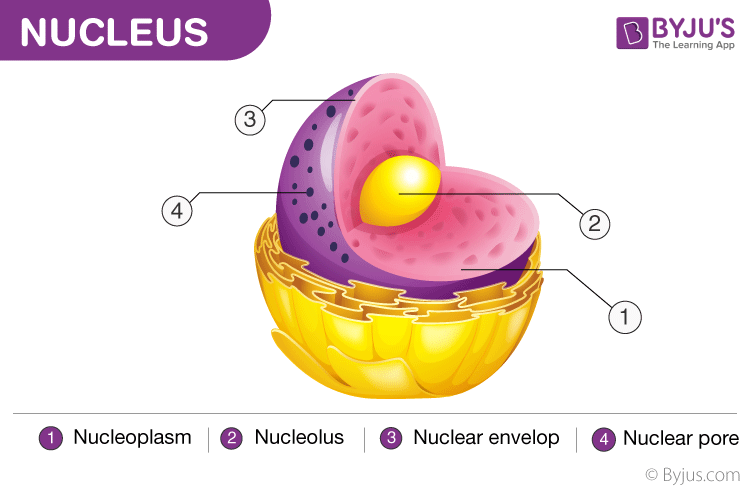
The nucleus is a double-membraned organelle found in all eukaryotic cells. It is the largest organelle, which functions as the control centre of the cellular activities and is the storehouse of the cell’s DNA. By structure, the nucleus is dark, round, surrounded by a nuclear membrane. It is a porous membrane (like cell membrane) and forms a wall between cytoplasm and nucleus. Within the nucleus, there are tiny spherical bodies called nucleolus. It also carries another essential structure called chromosomes.
Chromosomes are thin and thread-like structures which carry another important structure called a gene. Genes are a hereditary unit in organisms i.e., it helps in the inheritance of traits from one generation (parents) to another (offspring). Hence, the nucleus controls the characters and functions of cells in our body. The primary function of the nucleus is to monitor cellular activities including metabolism and growth by making use of DNA’s genetic information. Nucleoli in the nucleus are responsible for the synthesis of protein and RNA.
Also read about the Nucleus
Endoplasmic Reticulum
The Endoplasmic Reticulum is a network of membranous canals filled with fluid. They are the transport system of the cell, involved in transporting materials throughout the cell.
There are two different types of Endoplasmic Reticulum:
- Rough Endoplasmic Reticulum – They are composed of cisternae, tubules, and vesicles, which are found throughout the cell and are involved with protein manufacture.
- Smooth Endoplasmic Reticulum – They are the storage organelle, associated with the production of lipids, steroids, and also responsible for detoxifying the cell.
Also, read about Endoplasmic Reticulum
Mitochondria
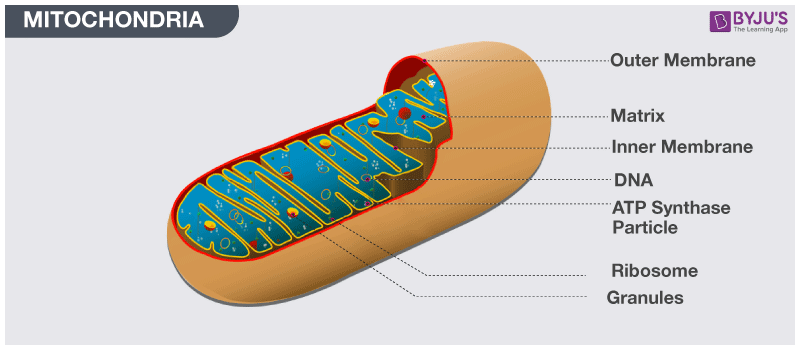
Mitochondria are called the powerhouses of the cell as they produce energy-rich molecules for the cell. The mitochondrial genome is inherited maternally in several organisms. It is a double membrane-bound, sausage-shaped organelle, found in almost all eukaryotic cells.
The double membranes divide its lumen into two distinct aqueous compartments. The inner compartment is called ‘matrix’ which is folded into cristae whereas the outer membrane forms a continuous boundary with the cytoplasm. They usually vary in their size and are found either round or oval in shape. Mitochondria are the sites of aerobic respiration in the cell, produces energy in the form of ATP and helps in the transformation of the molecules.
For instance, glucose is converted into adenosine triphosphate – ATP. Mitochondria have their own circular DNA, RNA molecules, ribosomes (the 70s), and a few other molecules that help in protein synthesis.
Also read about Mitochondria
Plastids
Plastids are large, membrane-bound organelles which contain pigments. Based on the type of pigments, plastids are of three types:

- Chloroplasts – Chloroplasts are double membrane-bound organelles, which usually vary in their shape – from a disc shape to spherical, discoid, oval and ribbon. They are present in mesophyll cells of leaves, which store chloroplasts and other carotenoid pigments. These pigments are responsible for trapping light energy for photosynthesis. The inner membrane encloses a space called the stroma. Flattened disc-like chlorophyll-containing structures known as thylakoids are arranged in a stacked manner like a pile of coins. Each pile is called as granum (plural: grana) and the thylakoids of different grana are connected by flat membranous tubules known as stromal lamella. Just like the mitochondrial matrix, the stroma of chloroplast also contains a double-stranded circular DNA, 70S ribosomes, and enzymes which required for the synthesis of carbohydrates and proteins.
- Chromoplasts – The chromoplasts include fat-soluble, carotenoid pigments like xanthophylls, carotene, etc. which provide the plants with their characteristic color – yellow, orange, red, etc.
- Leucoplasts – Leucoplasts are colorless plastids which store nutrients. Amyloplasts store carbohydrates (like starch in potatoes), aleuroplasts store proteins, and elaioplasts store oils and fats.
Also read about Plastids
Ribosomes
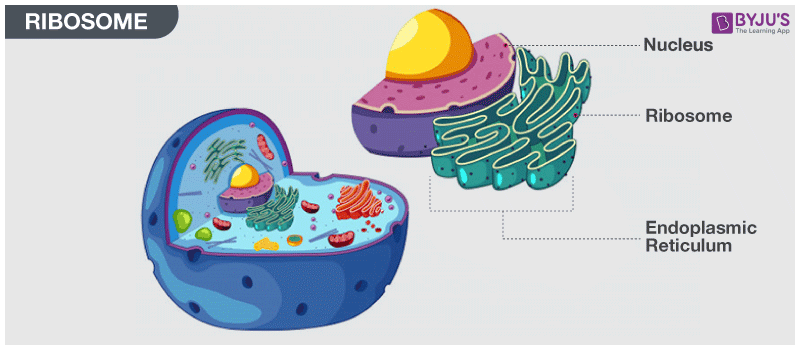
Ribosomes are nonmembrane-bound and important cytoplasmic organelles found in close association with the endoplasmic reticulum. Ribosomes are found in the form of tiny particles in a large number of cells and are mainly composed of 2/3rd of RNA and 1/3rd of protein. They are named as the 70s (found in prokaryotes) or 80s (found in eukaryotes) The letter S refers to the density and the size, known as Svedberg’s Unit. Both 70S and 80S ribosomes are composed of two sub-units. Ribosomes are either encompassed within the endoplasmic reticulum or are freely traced in the cell’s cytoplasm. Ribosomal RNA and Ribosomal proteins are the two components that together constitute ribosomes. The primary function of the ribosomes includes protein synthesis in all living cells that ensure the survival of the cell.
Also read about Ribosomes
Golgi Apparatus
Golgi Apparatus also termed as Golgi Complex. It is a membrane-bound organelle, which is mainly composed of a series of flattened, stacked pouches called cisternae. This cell organelle is primarily responsible for transporting, modifying, and packaging proteins and lipid to targeted destinations. Golgi Apparatus is found within the cytoplasm of a cell and are present in both plant and animal cells.
Also read about the Golgi Apparatus
Microbodies
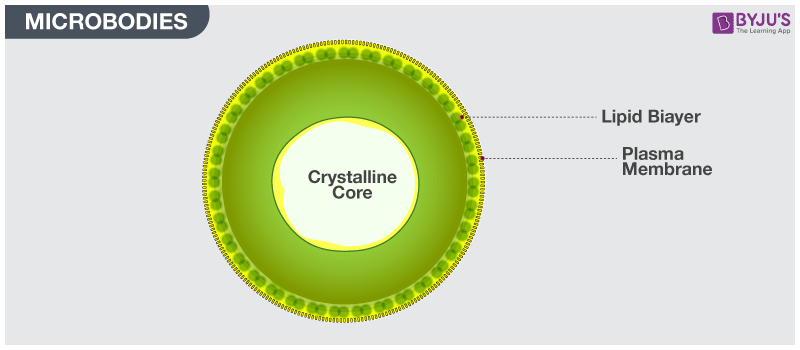
Microbodies are membrane-bound, minute, vesicular organelles, found in both plant and animal cell. They contain various enzymes and proteins and can be visualized only under the electron microscope.
Also read about Microbodies
Cytoskeleton
It is a continuous network of filamentous proteinaceous structures that run throughout the cytoplasm, from the nucleus to the plasma membrane. It is found in all living cells, notably in the eukaryotes. The cytoskeleton matrix is composed of different types of proteins that can divide rapidly or disassemble depending on the requirement of the cells. The primary functions include providing the shape and mechanical resistance to the cell against deformation, the contractile nature of the filaments helps in motility and during cytokinesis.
Also read about Cytoskeleton
Cilia and Flagella
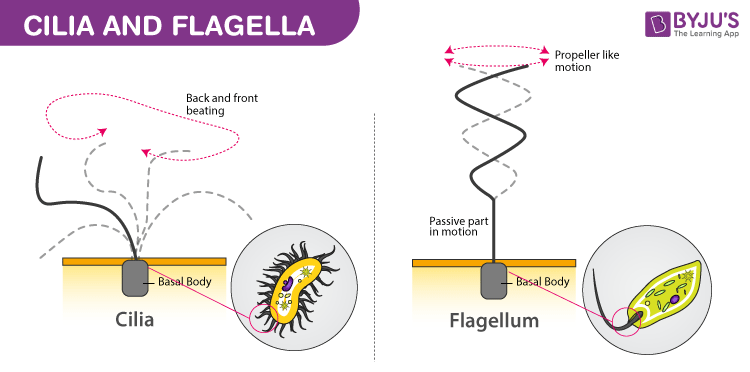
Cilia are hair-like projections, small structures, present outside the cell wall and work like oars to either move the cell or the extracellular fluid. Flagella are slightly bigger and are responsible for the cell movements. The eukaryotic flagellum structurally differs from its prokaryotic counterpart. The core of the cilium and flagellum is called a axoneme, which contains nine pairs of gradually arranged peripheral microtubules and a set of central microtubules running parallel to the axis. The central tubules are interconnected by a bridge and are embedded by a central sheath. One of the peripheral microtubular pairs is also interconnected to the central sheath by a radial spoke. Hence there is a total of 9 radial spokes. The cilia and flagella emerge from centriole-like structures called basal bodies.
Also read about the Difference Between Cilia And Flagella
Centrosome and Centrioles
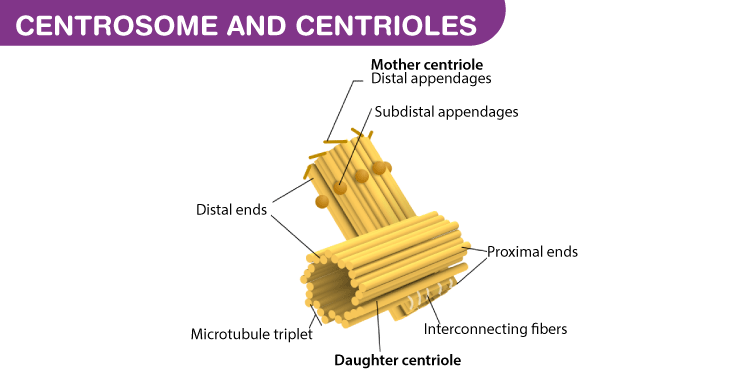
The centrosome organelle is made up of two mutually perpendicular structures known as centrioles. Each centriole is composed of 9 equally spaced peripheral fibrils of tubulin protein, and the fibril is a set of interlinked triplets. The core part of the centriole is known as a hub and is proteinaceous. The hub connects the peripheral fibrils via radial spoke, which is made up of proteins. The centrioles from the basal bodies of the cilia and flagella give rise to spindle fibres during cell division.
Also read about Centrosomes
Vacuoles
Vacuoles are mostly defined as storage bubbles of irregular shapes which are found in cells. They are fluid-filled organelles enclosed by a membrane. The vacuole stores the food or a variety of nutrients that a cell might need to survive. In addition to this, it also stores waste products. The waste products are eventually thrown out by vacuoles. Thus, the rest of the cell is protected from contamination. The animal and plant cell have different size and number of vacuoles. Compared to the animals, plant cell have larger vacuoles.
Also read about Vacuoles
A Brief Summary on Cell Organelles
| Cell Organelles | Structure |
Functions |
| Cell membrane | A double membrane composed of lipids and proteins. Present both in plant and animal cell. | Provides shape, protects the inner organelle of the cell and acts as a selectively permeable membrane. |
| Centrosomes | Composed of Centrioles and found only in the animal cells. | It plays a major role in organizing the microtubule and Cell division. |
| Chloroplasts | Present only in plant cells and contains a green-coloured pigment known as chlorophyll. | Sites of photosynthesis. |
| Cytoplasm | A jelly-like substance, which consists of water, dissolved nutrients and waste products of the cell. | Responsible for the cell’s metabolic activities. |
| Endoplasmic Reticulum | A network of membranous tubules, present within the cytoplasm of a cell. | Forms the skeletal framework of the cell, involved in the Detoxification, production of Lipids and proteins. |
| Golgi apparatus | Membrane-bound, sac-like organelles, present within the cytoplasm of the eukaryotic cells. | It is mainly involved in secretion and intracellular transport. |
| Lysosomes | A tiny, circular-shaped, single membrane-bound organelles, filled with digestive enzymes. | Helps in the digestion and removes wastes and digests dead and damaged cells. Therefore, it is also called as the “suicidal bags”. |
| Mitochondria | An oval-shaped, membrane-bound organelle, also called as the “Power House of The Cell”. | The main sites of cellular respiration and also involved in storing energy in the form of ATP molecules. |
| Nucleus | A largest, double membrane-bound organelles, which contains all the cell’s genetic information. | Controls the activity of the cell, helps in cell division and controls the hereditary characters. |
| Peroxisome | A membrane-bound cellular organelle present in the cytoplasm, which contains the reducing enzyme. | Involved in the metabolism of lipids and catabolism of long-chain fatty acids. |
| Plastids | Double membrane-bound organelles. There are 3 types of plastids:
|
Helps in the process of photosynthesis and pollination, Imparts colour for leaves, flowers and fruits and stores starch, proteins and fats. |
| Ribosomes | Non-membrane organelles, found floating freely in the cell’s cytoplasm or embedded within the endoplasmic reticulum. | Involved in the Synthesis of Proteins. |
| Vacuoles | A membrane-bound, fluid-filled organelle found within the cytoplasm. | Provide shape and rigidity to the plant cell and helps in digestion, excretion, and storage of substances. |
Important Question on Cell Organelles:
- Which cell organelle is called the Powerhouse of the cell?
Mitochondria is the cell organelle and is called the Powerhouse of the cell as they carry out the cellular respiration and generate the energy molecules called ATP or Adenosine Triphosphate.
- Where do we find Chloroplasts and Chromoplast pigments in plants?
Chloroplasts and Chromoplasts are the plastids present in all plant cells. Chloroplasts are the green colour pigments, present in the leaves, green-coloured stems, etc. Chromoplasts are the colourful pigments present in all colourful parts of the plant like flowers and fruits, etc.
-
Why Lysosomes are known as suicide bags?
Lysosomes are called the suicidal bags because they are capable of breaking down or digesting all the wastes, dead and damaged cells.
- What is Nucleoid?
Nucleoid is a non-membrane, irregular shaped cell organelle present in all prokaryotic cells. They are the carriers of the genetic material of a cell.
- The largest membrane-bound organelle in eukaryotic cell is?
Organelles are special and organized structures seen in living cells. Some of the membrane-bound organelles are vacuoles, nucleus, chloroplasts, lysosomes etc. The nucleus is the largest organelle in the cell.
Stay tuned with BYJU’S to learn more about the different types of Cell Organelles, their functions and other related topics at BYJU’S Biology

nice it help us
This is a really good article, nicely explained!
It is very helpful & very easy to understand.
Good
A Good you
BYJUS;
Is just like mitochondria for all the learners who really needs to explore the unexplored knowledge around them.
It helps a lot for me in develop the undeveloped knowledge around me.
Once again thank you BYJUS.
thanks for good information .
Thank you byjus for giving wonderful information to me
yes it helped me very much in my holiday homeworks
It is very helpful for students.
Really help full
iits really great and helpful to complete our notes in lockdowm
yes it isvery helpful in my holiday homework and learning the way also good
Very good app ??
very informative article ????
Very informative
Thank u Byju’s I am very great full to you u have cleared all doubts thanks for helping me???
Very good content by Byju’s ?????
Thank you for all who are working for this app, I got a clear study, and this is a good app for us to study?????
REALLY TOO GOOD
Nice and informative content
This app is so informative and useful to every student. As they explain each thing so clearly.
Byjus notes are very good and helpful ?????????
It is really very helpful for us.
Thank you so much
*Byjus*
Superb
I always use this website when I don’t understand anything or in trouble with my study
Thank You sooo much Byjus.
This helped me a lot